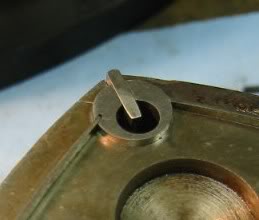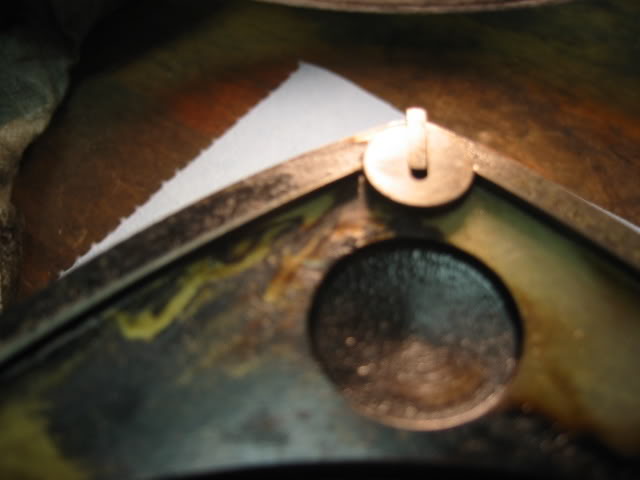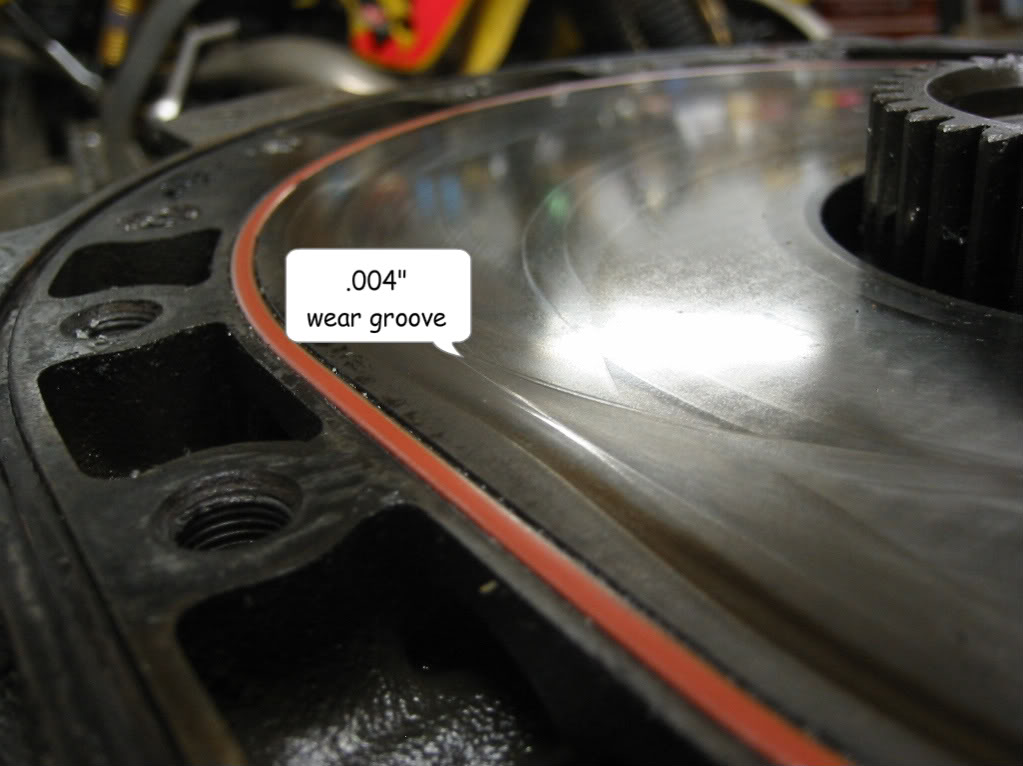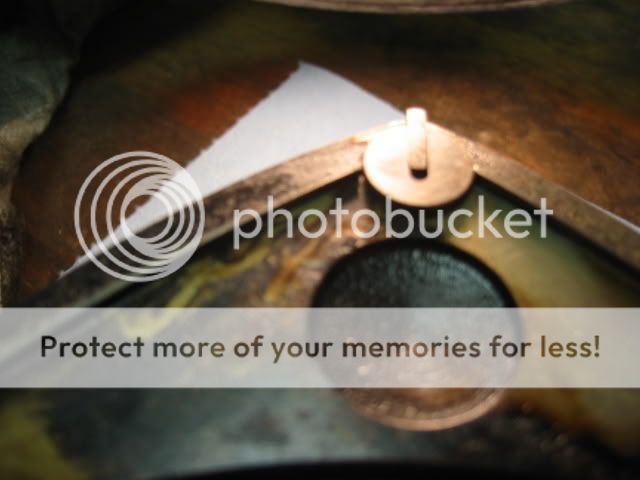Zero Clearance Side Seal
#1
I like to set up my side seals as tight a practical. There are different thoughts on this minimum spec.
I have seen recommendations from .002” -.004” for turbo applications.
On my last engine build-up I mistakenly switched two side seals causing a
.002” clearance. This resulted in scrapping the RE front plate because of a
.004” wear groove on it in the area of combustion (where heat/expansion is greatest).
I decided to try .000”! Found this in an early Mazda paper.
Barry Bordes

I have seen recommendations from .002” -.004” for turbo applications.
On my last engine build-up I mistakenly switched two side seals causing a
.002” clearance. This resulted in scrapping the RE front plate because of a
.004” wear groove on it in the area of combustion (where heat/expansion is greatest).
I decided to try .000”! Found this in an early Mazda paper.
Barry Bordes

#2
Originally Posted by 246rx7' post='901142' date='May 28 2008, 06:02 PM
I like to set up my side seals as tight a practical. There are different thoughts on this minimum spec.
I have seen recommendations from .002” -.004” for turbo applications.
On my last engine build-up I mistakenly switched two side seals causing a
.002” clearance. This resulted in scrapping the RE front plate because of a
.004” wear groove on it in the area of combustion (where heat/expansion is greatest).
I decided to try .000”! Found this in an early Mazda paper.
Barry Bordes

I have seen recommendations from .002” -.004” for turbo applications.
On my last engine build-up I mistakenly switched two side seals causing a
.002” clearance. This resulted in scrapping the RE front plate because of a
.004” wear groove on it in the area of combustion (where heat/expansion is greatest).
I decided to try .000”! Found this in an early Mazda paper.
Barry Bordes

Note that only one side of the corner seal has been involved. How is this possible if the problem is caused by too little end clearance? If the sides seals are getting too long for the space available in the groove, based on heat and end clearance, both sides of the corner seal would be involved.
So, in this picture, I suggest that end clearance was not a factor.
The rotors run at between 350 and 400 degrees, and so do the seals. The seals do get longer, but the rotors get bigger as well. So, any clearance remains about the same.
As the rotor turns, the drag from the side seal requires that the corner seal push it along. So all of the corner seals get a groove on one side but not the other.
So, as a result of the engine design, one side of each corner seal wears and one side does not. Likewise one end of each corner seal wears and one does not.
The wear involved in this picture would be a result of not top oil. The apex seals are hard enough to survive for quite a while with just fuel as a lubricant. The side seals will not last long at all. In some cases where the oil scrapers are whipped as well, you will see engines that have had not top oil at all running well but smoking a bit. The faulty scrapers allow enough oil by to keep the engine alive.
Since one end of each seal will soon wear a groove (however slight) into the corner seal, I set the clearance to zero.
Soon after breakin, there is some clearance, below .001" but some. You can run that engine two years with grear lubrication and find less than .004" on rebuild. Shifting at 9,600 RPM. I have been doing it since 1980 with no problems at all. On Red Line 2 cycle premixed at one ounce per gallon of 93 octane
fuel with no alcohol.
So long as the corner seal and both side seals will pop back up when released, that is enough clearance. Zero.
Lynn E. Hanover
#3
Lynn, thanks for the critique. Actually the picture of the diamond cut corner seal is my attempt at a fix for my binding side seals.
I run boosted with 50/50 water meth and this is what the rotor looks like at the corner seal interface.

On the previous engine build-up I mistakenly switched two side seals causing a .001"-.002” clearance. This resulted in scrapping the side plate because of a .004” wear groove on it in the area of combustion (where heat/expansion is greatest).

Does anyone know the part number of the old longer untrimmed side seals ?
The trimmed version of the Mazda side seal is part number is N3Y1-11-C11. There is a .055" longer untrimmed version, but Ray Crowe could not find it. He ordered an older number but it turned out to be thicker (.8mm instead of .7mm).
Barry
I run boosted with 50/50 water meth and this is what the rotor looks like at the corner seal interface.

On the previous engine build-up I mistakenly switched two side seals causing a .001"-.002” clearance. This resulted in scrapping the side plate because of a .004” wear groove on it in the area of combustion (where heat/expansion is greatest).

Does anyone know the part number of the old longer untrimmed side seals ?
The trimmed version of the Mazda side seal is part number is N3Y1-11-C11. There is a .055" longer untrimmed version, but Ray Crowe could not find it. He ordered an older number but it turned out to be thicker (.8mm instead of .7mm).
Barry
#4
Originally Posted by 246rx7' post='901159' date='May 29 2008, 05:08 AM
Lynn, thanks for the critique. Actually the picture of the diamond cut corner seal is my attempt at a fix for my binding side seals.
I run boosted with 50/50 water meth and this is what the rotor looks like at the corner seal interface.

On the previous engine build-up I mistakenly switched two side seals causing a .001"-.002” clearance. This resulted in scrapping the side plate because of a .004” wear groove on it in the area of combustion (where heat/expansion is greatest).

Does anyone know the part number of the old longer untrimmed side seals ?
The trimmed version of the Mazda side seal is part number is N3Y1-11-C11. There is a .055" longer untrimmed version, but Ray Crowe could not find it. He ordered an older number but it turned out to be thicker (.8mm instead of .7mm).
Barry
I run boosted with 50/50 water meth and this is what the rotor looks like at the corner seal interface.

On the previous engine build-up I mistakenly switched two side seals causing a .001"-.002” clearance. This resulted in scrapping the side plate because of a .004” wear groove on it in the area of combustion (where heat/expansion is greatest).

Does anyone know the part number of the old longer untrimmed side seals ?
The trimmed version of the Mazda side seal is part number is N3Y1-11-C11. There is a .055" longer untrimmed version, but Ray Crowe could not find it. He ordered an older number but it turned out to be thicker (.8mm instead of .7mm).
Barry
Atkins sells the older longer seals.
#5
Too_slow thanks,
I use the Atkins seals. But they incorrectly package them as N3Y1-11-C11, which is the part number for the Mazda close-trim seals. They told me that they are genuine Mazda seals but I wonder because it shouldn't have the same part number.
Barry
I use the Atkins seals. But they incorrectly package them as N3Y1-11-C11, which is the part number for the Mazda close-trim seals. They told me that they are genuine Mazda seals but I wonder because it shouldn't have the same part number.
Barry
#6
Originally Posted by 246rx7' post='901163' date='May 29 2008, 01:59 PM
Too_slow thanks,
I use the Atkins seals. But they incorrectly package them as N3Y1-11-C11, which is the part number for the Mazda close-trim seals. They told me that they are genuine Mazda seals but I wonder because it shouldn't have the same part number.
Barry
I use the Atkins seals. But they incorrectly package them as N3Y1-11-C11, which is the part number for the Mazda close-trim seals. They told me that they are genuine Mazda seals but I wonder because it shouldn't have the same part number.
Barry
I used the RA ones and had to trim each and every seal.

#7
I don't know if too tight a side seal to corner seal clearance is good, if you disassemble a used factory rotary you will notice there is only one wear mark on the side of the corner seal on the trailing side due to sliding friction of the seal on the plate. Now imagine the seal is a bit longer and you get 2 marks on the corner seal, this would indicate the seal is butting up against the corners seals and is restricted in it's expansion. You would think this is OK as it is sealing the end gap, but the seal is restricted and has to bow in the centre, or the ends run up the radius of the corner seals, either way the seal is lifted off the back(oil ring side) of the groove, it's the seal resting against the back of the groove that allows the seal to seal gasses. If it is lifted the gasses have a path to escape, ie down the front of the seal around the bottom and out the back. Same as a piston engine, the ring resting on the bottom of the ring groove is what does the sealing. Next time look at a used side seal and you will see shiny marks on the inside of the seal as it is pushed against the side seal groove except for the trailing end. With the trailing end the seal rides up the radius of the corner seal and leaves a gap behind the seal so there is some leakage and the area may have carbon deposits in the area. Butting side seal will also press against corner seals and may squash them(keyhole type), or lift them off the back of their bores as well.
#8
Originally Posted by 246rx7' post='901163' date='May 29 2008, 05:59 AM
Too_slow thanks,
I use the Atkins seals. But they incorrectly package them as N3Y1-11-C11, which is the part number for the Mazda close-trim seals. They told me that they are genuine Mazda seals but I wonder because it shouldn't have the same part number.
Barry
I use the Atkins seals. But they incorrectly package them as N3Y1-11-C11, which is the part number for the Mazda close-trim seals. They told me that they are genuine Mazda seals but I wonder because it shouldn't have the same part number.
Barry
the "untrimmed" seals are for the older engines, 1011-23-151A, 1mm vs the 86+ .7mm
the untrimmed seals are actually for the 68-73 engines, which had 2 side seals, a long and a short, thats why they are so long! the more correct part number for the 1mm side seal engines is 8871-23-151.
the 86+ engines never had any other side seal arrangement, so theres just the 2 part numbers, turbo and non
#9
Originally Posted by j9fd3s' post='901212' date='May 30 2008, 10:36 AM
the "untrimmed" seals are for the older engines, 1011-23-151A, 1mm vs the 86+ .7mm
the untrimmed seals are actually for the 68-73 engines, which had 2 side seals, a long and a short, thats why they are so long! the more correct part number for the 1mm side seal engines is 8871-23-151.
the 86+ engines never had any other side seal arrangement, so theres just the 2 part numbers, turbo and non
the untrimmed seals are actually for the 68-73 engines, which had 2 side seals, a long and a short, thats why they are so long! the more correct part number for the 1mm side seal engines is 8871-23-151.
the 86+ engines never had any other side seal arrangement, so theres just the 2 part numbers, turbo and non
j9fd3s thanks for your interest.
Am I to understand that there are no .7mm longer side seals made by Mazda?
Barry
#10
Lynn, my intent is to increase sealing with no loss of longevity.
Thanks, Barry
Originally Posted by Lynn ityE. Hanover' post='901158' date='May 29 2008, 04:23 AM
Note that only one side of the corner seal has been involved. How is this possible if the problem is caused by too little end clearance? If the sides seals are getting too long for the space available in the groove, based on heat and end clearance, both sides of the corner seal would be involved.
My thought is that with .000" clearance the seal jams and cuts the plate,
So, in this picture, I suggest that end clearance was not a factor.
The rotors run at between 350 and 400 degrees, and so do the seals. The seals do get longer, but the rotors get bigger as well. So, any clearance remains about the same.
As the rotor turns, the drag from the side seal requires that the corner seal push it along. So all of the corner seals get a groove on one side but not the other.
So, as a result of the engine design, one side of each corner seal wears and one side does not. Likewise one end of each corner seal wears and one does not.
The wear involved in this picture would be a result of not top oil. The apex seals are hard enough to survive for quite a while with just fuel as a lubricant. The side seals will not last long at all. In some cases where the oil scrapers are whipped as well, you will see engines that have had not top oil at all running well but smoking a bit. The faulty scrapers allow enough oil by to keep the engine alive.
The wear was only on one side of one plate (the front plate).
Since one end of each seal will soon wear a groove (however slight) into the corner seal, I set the clearance to zero.
Soon after breakin, there is some clearance, below .001" but some. You can run that engine two years with grear lubrication and find less than .004" on rebuild. Shifting at 9,600 RPM. I have been doing it since 1980 with no problems at all. On Red Line 2 cycle premixed at one ounce per gallon of 93 octane
fuel with no alcohol.
So long as the corner seal and both side seals will pop back up when released, that is enough clearance. Zero.
Lynn E. Hanover
My thought is that with .000" clearance the seal jams and cuts the plate,
So, in this picture, I suggest that end clearance was not a factor.
The rotors run at between 350 and 400 degrees, and so do the seals. The seals do get longer, but the rotors get bigger as well. So, any clearance remains about the same.
As the rotor turns, the drag from the side seal requires that the corner seal push it along. So all of the corner seals get a groove on one side but not the other.
So, as a result of the engine design, one side of each corner seal wears and one side does not. Likewise one end of each corner seal wears and one does not.
The wear involved in this picture would be a result of not top oil. The apex seals are hard enough to survive for quite a while with just fuel as a lubricant. The side seals will not last long at all. In some cases where the oil scrapers are whipped as well, you will see engines that have had not top oil at all running well but smoking a bit. The faulty scrapers allow enough oil by to keep the engine alive.
The wear was only on one side of one plate (the front plate).
Since one end of each seal will soon wear a groove (however slight) into the corner seal, I set the clearance to zero.
Soon after breakin, there is some clearance, below .001" but some. You can run that engine two years with grear lubrication and find less than .004" on rebuild. Shifting at 9,600 RPM. I have been doing it since 1980 with no problems at all. On Red Line 2 cycle premixed at one ounce per gallon of 93 octane
fuel with no alcohol.
So long as the corner seal and both side seals will pop back up when released, that is enough clearance. Zero.
Lynn E. Hanover
Thanks, Barry



